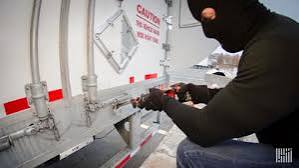Canadian Police Seize Trucks Transporting $47 Million Worth of Cocaine; $1.6 Million in Stolen Electronics Recovered in the U.S.
In a massive international operation that highlights the increasing coordination between cross-border criminal organizations, Canadian law enforcement officials recently seized trucks carrying an astonishing $47 million worth of cocaine. In a related breakthrough, U.S. authorities managed to recover $1.6 million worth of stolen electronics, shedding light on an intricate web of drug smuggling and stolen goods trafficking spanning both nations.
The drug bust, one of the largest in recent Canadian history, underscores the growing sophistication of trafficking networks operating between Canada and the United States. According to the Royal Canadian Mounted Police (RCMP), the operation began months ago with intelligence gathered from multiple law enforcement agencies. The investigation eventually led to the interception of commercial transport trucks at key checkpoints in Ontario, where authorities uncovered more than 500 kilograms of cocaine concealed within legitimate cargo.
Officials described the bust as a “significant disruption” to a major criminal enterprise. The cocaine was packed in bricks and hidden in compartments designed to avoid detection by border security. RCMP officials believe the drugs were destined for distribution hubs across major Canadian cities, including Toronto, Montreal, and Vancouver.
Superintendent Jason Crowley of the RCMP’s Organized Crime Division stated, “This seizure is a testament to the power of intelligence-led policing and cross-border cooperation. We were able to intercept millions of doses of illegal narcotics before they could hit our streets. That means lives saved, communities protected, and a serious blow to organized crime.”
While the drug seizure took place on Canadian soil, investigators believe the cocaine originated from South America and made its way north through the U.S. using commercial supply chains. The smuggling network relied on legitimate freight operations to conceal the drugs among regular cargo—making it harder for law enforcement to detect the contraband.
The case took another twist when, in a coordinated action, U.S. federal agents recovered $1.6 million in stolen electronics believed to be tied to the same criminal network. The stolen goods were found in warehouses across Michigan and Illinois, where authorities discovered large quantities of high-end devices such as smartphones, tablets, laptops, and gaming consoles. Investigators believe the electronics were intended for resale in black markets in both the U.S. and Canada, with profits possibly funding further drug operations.
According to U.S. Homeland Security Investigations (HSI), the stolen electronics had been rerouted from hijacked shipments, and some of the items had already been listed on online marketplaces under fake seller accounts. Authorities are now working with tech companies to track and deactivate serial numbers of the stolen products and to trace any financial transactions connected to the illegal sales.
The dual breakthroughs in Canada and the U.S. were made possible through collaboration between the RCMP, Canada Border Services Agency (CBSA), U.S. Customs and Border Protection, Homeland Security Investigations, and local law enforcement agencies on both sides of the border. Officials highlighted the role of intelligence sharing, data analytics, and surveillance in tracking the criminal syndicate’s logistics and operations.
Authorities have so far arrested five individuals—three in Canada and two in the U.S.—in connection with the drug trafficking and stolen goods ring. The suspects are facing multiple charges, including trafficking of a controlled substance, possession of property obtained by crime, conspiracy to commit an indictable offense, and importation of narcotics. Law enforcement officials say additional arrests are expected as the investigation continues.
RCMP emphasized that organized crime syndicates are becoming increasingly tech-savvy and business-oriented, mimicking the methods of legitimate shipping and logistics companies. “This wasn’t just about drugs or stolen electronics,” said Superintendent Crowley. “This was about an entire criminal business model—one that was highly organized, efficient, and adaptable.”
The bust is also prompting renewed discussion about improving border security and increasing the use of scanning technologies, AI-driven inspections, and real-time intelligence updates to detect suspicious cargo more effectively.
Public safety experts say this case is a wake-up call for both countries, showing how deeply entrenched and wide-reaching these criminal operations can be. Many are calling for continued investment in cross-border task forces and stronger penalties for those found operating or aiding such networks.
As investigations move forward, authorities are committed to unraveling the full scope of the trafficking ring’s operations, including possible links to larger international drug cartels and fencing networks. The case serves as a stark reminder of the ever-evolving challenges faced by law enforcement in combating organized crime in the 21st century.
Ultimately, the coordinated effort stands as a significant victory against a dangerous and lucrative criminal enterprise—and a warning to others that law enforcement is watching, cooperating, and ready to act.

